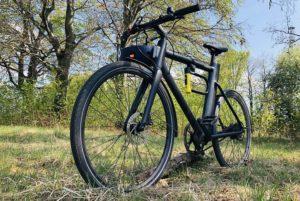The Camping Feed Staff are constantly on the hunt for the best mountain bikes of 2025. Our mission focuses on unbiased product reviews, comparisons, and a helpful guide to keep you up-to-date with the latest trail mountain bikes.
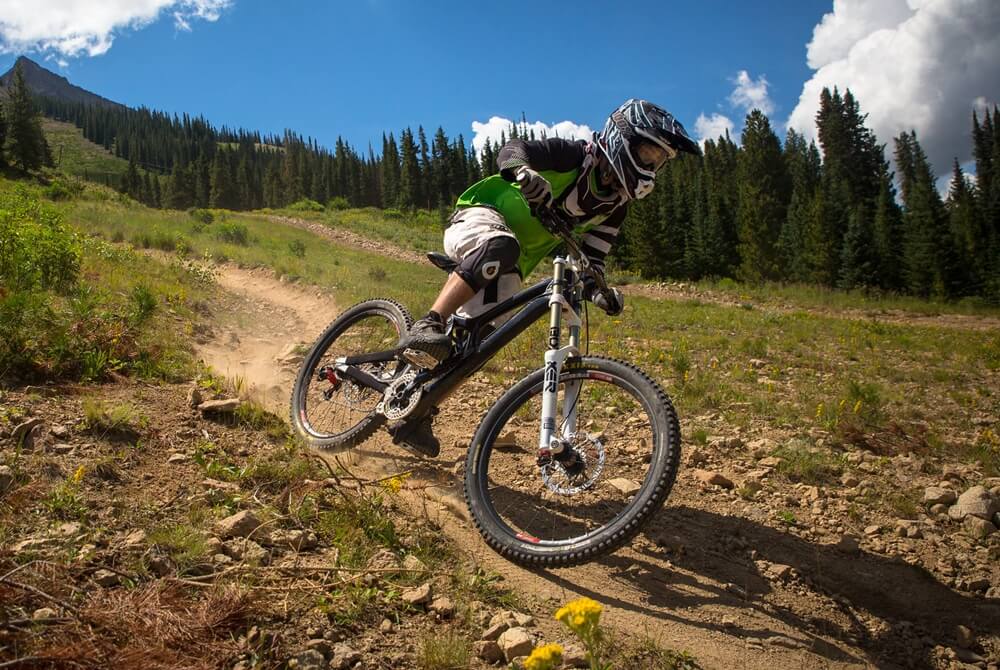
By: Camping Feed Staff | Last Updated: Jan. 25, 2025
Every year an army of exciting new best mountain bikes hit the market, and it’s easy for you to get caught up in all of the hype. But how do you know which models are actually worth the cash? We put hundreds of high-end mountain bikes through rigorous testing at the Camping Feed to create our annual buyers’ guide. The result, an honest list of the best mountain bikes of 2025 from top brands and for every budget.
Whether your favorite adventure is conquering singletrack, lapping the bike park, shredding the dirt jumps, or tearing up a cyclocross race, we have you covered.
A bike needs to have exceptional brakes, a comfortable and efficient suspension system, and a durable yet lightweight frame to be included in our list. This year’s lineup is full of new and refined models that can keep up with herds of mountain bikers at any skill level. Please think of this as an updated guide to our favorite bikes introduced in the past year. What we like about this list is we know it will make you a better mountain biker. Our testing and feedback from the professional and everyday riders give us valuable insight into all types of riders. We can confidently say that these are the best mountain bikes of 2025.
The Best Overall Trail Mountain Bike
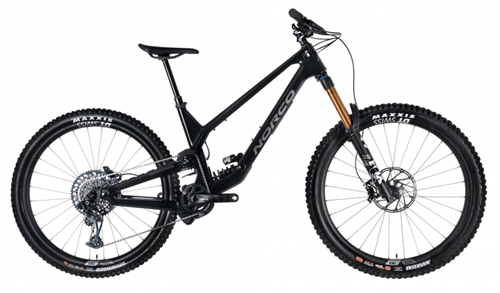
1. Norco Range C1
- Frame: made of carbon fiber
- Tires: front – 29 x 2.5 in., rear – 29 x 2.4 in.
- Suspension: 170mm (front), 170mm (rear)
- Weight: 37.05 lbs
- Pros: Outstanding Suspension Performance, Quiet Ride, Low standover with great center of gravity
- Cons: Lots of Hardware, Cable Routing can be hard to understand
When it comes to the best mountain bikes of 2025, at the Camping Feed, we’ve named Norco’s Range C1 the best overall trail mountain bike on the list.
Norco’s 2022 Range C1 is the enduro bike we all dream of, especially if you are trying to keep up with any downhill bike. The Range C1 has incredible suspension performance and provides a quiet ride for cyclists!
With smooth lines and frame design, Norco’s Range C1 provides the ride every mountain biker dreams of for a day on the trails. The Range features 170 mm of wheel travel (from the front to the rear). The bike is available in various sizes, including S, M, L, and XL.
At Camping Feed, one of our favorite features of Norco’s Range C1 is that it is wholly constructed of carbon fiber and weighs 37.05 pounds. As a result, the Range C1 has a great center of gravity, making it easy to maneuver on the mountain.
Best Trail Bike Under $3000
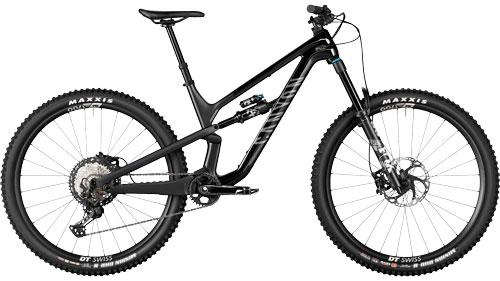
2. Canyon Spectral CF 8.0
- Frame: Carbon fiber/Aluminum
- Tires: 27.5 x 2.6 in.
- Suspension: 150mm (front), 140mm (rear)
- Weight: 29.92 lbs
- Pros: Well designed frame, Great suspension, Durable
- Cons: Tall Head and Seat Tube Limit Versatility
Canyon’s Spectral CF 8.0 has made it onto our list as the best trail bike under $3,000. We love the new look and build at the Camping Feed that Canyon has introduced with the Spectral CF 8.0.
And, if we’re being honest about it, it’s about time! After four years, the new design includes a total shift in the orientation of the shocks. Instead of being horizontal, they now lie vertically on the bike.
With all of the changes Canyon introduced in the new Spectral, you can expect to feel more stability in your ride. And, for the cost, it is far more sensitive than the previous model.
Canyon’s Spectral CF 8.0 is carbon-framed and comes with highly reliable wheels. While the brakes are not top of the line, they work well. In addition, the frame is designed well and is very durable.
We love that Canyon’s Spectral CF 8.0 weighs 29.92 pounds. The suspension in this bike is also great, which is another reason why we’ve listed it as the best trail bike under $3,000.
Best Budget Mountain Bike
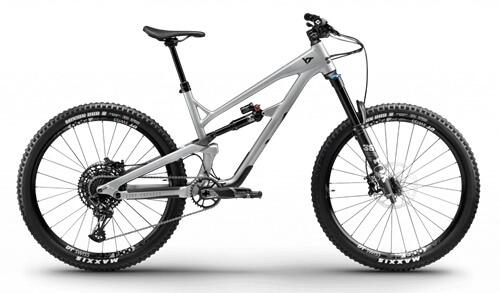
3. YT Jeffsy Core 2
- Frame: Aluminum
- Tires: 27.5 x 2.4 in (29 in. options)
- Suspension: 160 mm
- Weight: 33.29 lbs
- Pros: Unisex, Lots of Size and Wheel Options, Lots of pop and control
- Cons: Harder for fast acceleration
YT-Industries’ Jeffsy Core 2 is the best budget mountain bike on our list for 2025. It is available in five different sizes, making it easy to find the bike that fits your body size. And, it has a few additional features that make it a great entry-level mountain bike.
At the Camping Feed, we love the Jeffsy Core 2 because it is unisex, and various wheel options are available. So whether you are a beginner or you’ve been biking on mountains for years, the Jeffsy Core 2 will fit your needs. In addition, it is made of aluminum, which makes it solid and durable.
The Jeffsy Core 2 has a lot of pop and control; it weighs 33.29 pounds. It is a robust bike that is built with quality components. While it can be harder to accelerate on the mountain quickly, we can easily overlook this minor flaw for the price point (USD 2,799). After considering its features, this mountain bike is worth trying out.
YT offers a five-year warranty for crashes and service on your Jeffsy Core 2, which is always a plus when you’re about to invest in something like a mountain bike.
Best Short-Travel Trail Bike
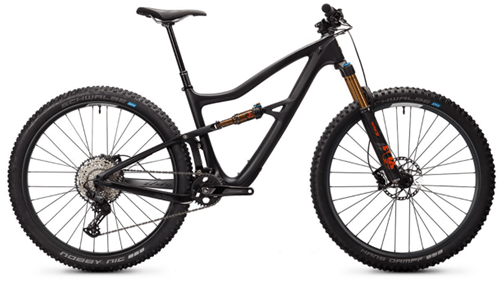
4. Ibis Ripley Deore
- Frame: Carbon fiber
- Tires: 29 x 2.6 in.
- Suspension: 130mm (front), 120mm (rear)
- Weight: 5.0 lbs
- Pros: Lightweight, Versatile, Good Build for price with DW link Suspension
- Cons: Seat is not comfy
Ibis’ Ripley Deore is the best short-travel trail bike on the market. When first released, Ibis claimed that it would be a “game-changer.” After riding the Ripley, we agree. It’s a good choice for those who want to ride trails and need a versatile bike. And, coming in at 5 pounds, this is one of the lightest bikes on our list.
You can ride the Ripley anywhere from flow trails to free riding down the local hill. It’s an excellent bike for someone looking for a do-it-all type of ride, and it is sure to last you through some hard riding.
Ibis has done a fine job designing the Ripley as an all-around machine for most types of riding. The suspension stays active under power, but it’s stiff enough to be pedaled efficiently.
Ibis made the Ripley longer and steeper to give riders more control. And, Ibis took what was good about their aluminum Ripley and added some nice upgrades to the carbon fiber version, making it a lighter and better handling trail bike. The carbon fiber frame is beautiful, too.
Overall, we love this bike at the Camping Feed because it’s speedy and quite fun to ride! Featuring a 120mm rear end, the Ripley is capable of handling all types of terrain.
Best Mid-Travel Trail Bike
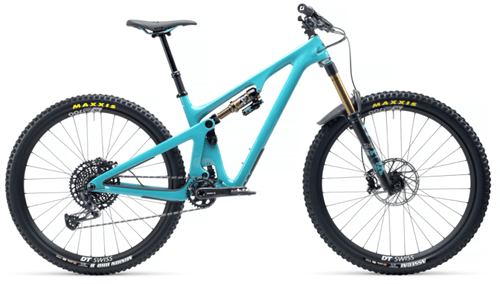
5. Yeti SB130 TURQ X01
- Frame: Carbon fiber
- Tires: 29 x 2.5 in. (front), 29 x 2.3 in. (rear)
- Suspension: 150mm (front), 130mm (rear)
- Weight: 29.9 lbs
- Pros: Light weight, Accelerates well even uphill, Great for technical climbs
- Cons: For experienced riders and people riding hard
The high-end Yeti SB130 TURQ X01 is the best mid-travel trail bike on our list this year. Every component on this bike is high quality and well designed to work together, making for an excellent ride that’s easy to control. And the reasonable price certainly doesn’t hurt either.
While some riders may be disappointed by the relatively short rear-wheel travel, others dislike the lightweight Yeti SB130. But you have to admit that it’s surprisingly efficient for its size.
This bike is from a new line from Yeti, the SB series, which stands for Switch Infinity. The Yeti SB130 TURQ X01 comes in four sizes, from small to extra-large, and five colors. The Carbon frame is light and stiff due to the alloy construction, and it’s described as having “a playful demeanor that begs for trail play.”
It features a tapered headtube, internal cable routing, and a damping system in the fork. The bike has excellent geometry, too. The Switch Infinity suspension also makes for a very active rear end that is ready to pop off the ground despite the relatively modest amount of travel it has.
This bike may be small in travel terms, but it’s significant in the fun factor. It’s ready to party, and it doesn’t care if you are or not; which is why we love this bike!
Best Hardtail Trail Mountain Bike
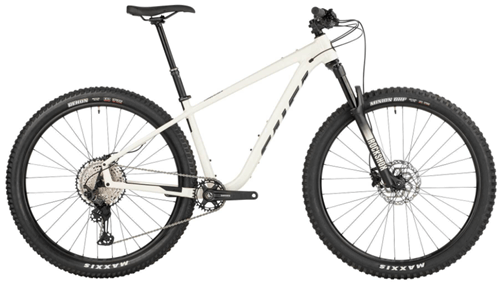
6. Salsa Timberjack XT 29
- Frame: Carbon fiber/Aluminum
- Tires: 27.5 x 2.8 in or 29 x 2.1-2.6 in
- Suspension: 130mm (front), 150mm (rear)
- Weight: 31.1 lbs
- Pros: Fast on straightaways, Great for beginners, Comfortable and Fun, Great features
- Cons: Front end stability can be shaky on downhills, Expensive
There are other 29ers out there, but the Timberjack XT 29 is the ideal hardtail for someone who wants to ride and play! The original Timberjack was released in 2010 and was immediately embraced by riders who wished for a confident-handling hardtail that could go fast, corner like a champ, and climb like a mountain goat. The Timberjack XT 29 builds on that legacy.
The XT 29’s frame’s geometry offers an inspiring blend of stability and agility to conquer the ups and carve through the downs. Salsa’s new suspension system provides 130mm of plush travel over the front end while also bringing the seat stay pivot to the rear axle, ensuring that your power goes precisely where you point it. In addition, the Timberjack XT 29’s frame is built tough with aluminum and carbon fiber. Salsa also threw in rack mounts for extra storage, leaving your backpack free for food, water, and whatever else you might need on your epic rides.
At the Camping Feed, we believe this bike is a standout when it comes to value. It’s a solid choice for a wide variety of riding styles and at a price that won’t break the bank. If you’re looking for a snappy yet smooth-rolling hardtail with minimal weight and maximum fun, the Timberjack XT 29 is a great place to start.
Best 27.5-inch Trail Bike
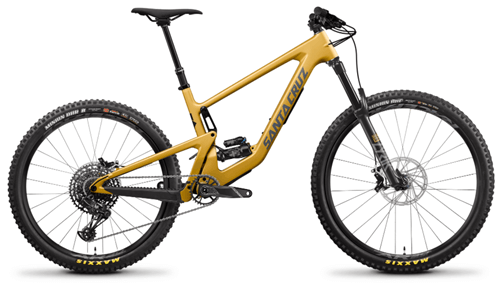
7. Santa Cruz Bicycles Bronson 4 R C MX
- Frame: Carbon fiber
- Tires: 29 x 2.6 in. (front), 27.5 x 2.6 in. (rear)
- Suspension: 160mm (front), 150mm (rear)
- Weight: 32.89 lbs
- Pros: Fun to ride, Great for larger obstacles on the trail, Great warranty from the company
- Cons: Brakes aren’t the smoothest
Coming in as the best 27.5-inch trail bike of 2025 is Santa Cruz’ Bronson 4 R C MX.
The Bronson’s single pivot suspension is based around an aluminum VPP (Virtual Pivot Point) link with 150mm of travel. The VPP design allows the rear wheel to move in two planes, which means that there’s no wasted energy. When you push into a turn, the wheel naturally moves up and over the obstacle, and then the natural ‘plunk’ of the VPP system brings it back down onto the ground. It works well for bigger jumps, too: the wheel moves up and out of the way while still providing support because it’s moving in two dimensions.
The Bronson is a fast bike! You can get up to speed quickly, stay there, and enjoy it for longer than other bikes. It can handle any terrain, but it shines when there are many corners and technical features to ride through.
Tire traction counts for a lot on a trail bike, and the Bronson does not disappoint. With 27.5-inch wheels, the Bronson 4 R C MX can take on everything from high-speed descents to technical climbs.
At the Camping Feed, we know that Santa Cruz is known for its attention to detail, and the design of this bike shows it. A stiff frame, sturdy fork, and solid wheels and tires make sure that you will be able to navigate any obstacle in front of you. There’s no harsh ride on this machine; it is comfortable and fun to ride whether you are going fast or slow.
Best Cross-country Bike
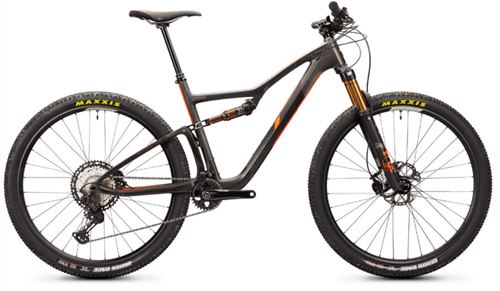
8. Ibis Exie XT
- Frame: Carbon fiber
- Tires: 29 x 2.4 in.
- Suspension: 120mm (front), 100mm (rear)
- Weight: 4.4 lbs
- Pros: Lightweight, Great for the trail, Easy to use
- Cons: Not as many features/bells and whistles
Are you ready to push your limits on the trail? Do you want to crush hills on the regular? Then you need the next bike on our list.
The 2025 best cross-country bike is Ibis’ Exie XT.
The Exie is a race bike with a carbon frame, a 2.4″ tire clearance, a threaded bottom bracket, and an inspirational design! Ibis’ Exie XT has tubeless aluminum rims, which encourages fewer flats while you’re riding.
The cross-country race bike will have 120mm of travel on the front and 100mm on the rear. The Exie uses a DW-Link Suspension with an adjustable head angle from 69 degrees to 69.5 degrees and a seat angle from 74 degrees to 74.5 degrees. This bike is best for cross-country racing, but you can also enjoy it on longer rides with friends or the trails. This bike’s components are all top of the line and offer excellent performance for any rider looking to take on any terrain!
Best Enduro Bike
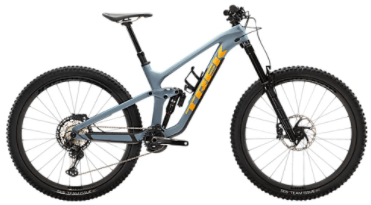
9. Trek Slash 9.8 XT
- Frame: Carbon fiber
- Tires: 29 x 2.5 in.
- Suspension: 130 mm (front) / 160 mm (rear)
- Weight: 32.10 lbs
- Pros: Great Feel on Suspension, Stable at high speeds, Great traction
- Cons: Hard to steer at slow speeds, Not the best for hills
Trek’s Slash 9.8 XT is the ultimate long-travel 29er for enduro, xc, and trail riders who are looking to push their limits.
The Slash 9.8 XT is roomy, has an aggressive fit, and has a carbon frame that makes it stiff and strong. The 130mm front and 160mm rear travel is more than enough for any trail or enduro course, and the geometry is designed to inspire confidence so you can charge harder, ride faster, and have more fun.
The Slash 9.8 XT is a super-capable, big-hit bike that can be ridden hard and fast thanks to its carbon frame and proven suspension tech. The structure, paired with short chainstays, provides quick handling and explosive acceleration.
The carbon frame, wheels, and carbon components of the Slash 9.8 XT set it far apart from any other bike in its category. The Trek Slash is built to shred through the most challenging terrain on earth with ease. The wheels are ideal for tackling the steepest climbs and ripping down the most technical trails with precision handling.
At the Camping Feed, we think Trek’s Slash 9.8 XT is 2025’s best enduro bike!
Best Downhill Mountain Bike
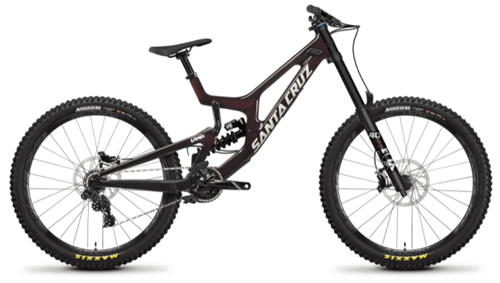
10. Santa Cruz V10
- Frame: Carbon fiber
- Tires: 27.5 x 2.5 in or 29 in available
- Suspension: 200mm (front), 215mm (rear)
- Weight: 35.09 lbs
- Pros: Well balanced, Excellent Stability at High Speeds, Adjustable Chainstays
- Cons: Not Ideal for Shorter Riders, Price can be expensive for beginners
The idea was to create a bike that inspires confidence, no matter how hard you ride it.
The V10 is the culmination of nearly two decades of continuous innovation. We believe the V10 is the best downhill mountain bike Santa Cruz has ever made at the Camping Feed.
It’s lighter and more playful than any previous Santa Cruz downhill frame and still has all of the durability features that they are known for. If you want to be a downhill racer, you can enjoy the best suspension technology and geometry that Santa Cruz offers with its V10.
The new VPP link with its more minor pivot allows the frame to be longer, slack, low, and tight with 215mm of VPP™ travel. Plus, the VPP suspension system is incredibly refined and easy to tune. Your bike is tailored for your body size, so you get the best possible fit for your riding style.
The V10 is one of the most exciting and aggressive downhill-mountain bikes we have ever tested at the Camping Feed. And, while you may not be racing yet, you want the best bike out there. If this sounds like you, then investing in Santa Cruz’s V10 is the perfect downhill mountain bike to fit your needs!
Best Electric Mountain Trail Bike
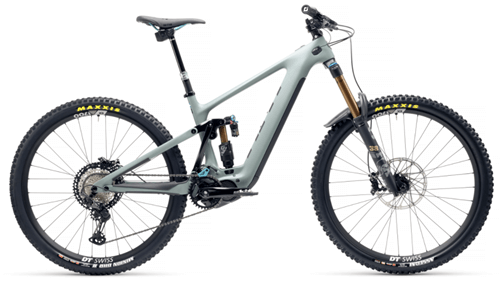
11. Yeti Cycles – 160E C1
- Frame: Carbon fiber
- Tires: 29 x 2.5 in. (front), 29 x 2.4 in. (rear)
- Suspension: 170mm (front), 160mm (rear)
- Weight: 50 lbs
- Pros: Lifetime warranty, Active suspension, Stable and Comfortable, Silent
- Cons: Expensive, Brake and Shifter are challenging, No geometry adjustments or mixed wheel options
E-bikes are becoming more and more mainstream. Most brands have at least one model in their lineup, with the notable exception of Yeti. Now, Yeti has announced it will join the e-biking fray with a new model of its own.
Yeti’s 160E is a trail bike with a motor that does everything it can to be as unnoticeable as possible. Yeti’s goal is to create a bike that behaves just like a trail bike should, but with that extra power when you need it.
The 160E achieves this via a unique pivot point in the suspension linkage design. In addition, the 160E is designed to put the power where you need it most, with a short chainstay paired with a long front center. The result is a bike that’s able to climb like crazy while maintaining the same low center of gravity as Yeti’s regular trail bikes.
Yeti has engineered the 160E around similar geometry to its other machines, with a long top tube and short front center, creating a more responsive ride feel while allowing riders of varying heights to find the correct position.
Yeti says the 160E is aimed at riders who want to use their bikes to climb without breaking a sweat but still want to be able to rip downhill when they get there. That sounds like exactly what we want out of an e-bike.
Best Fat Bike
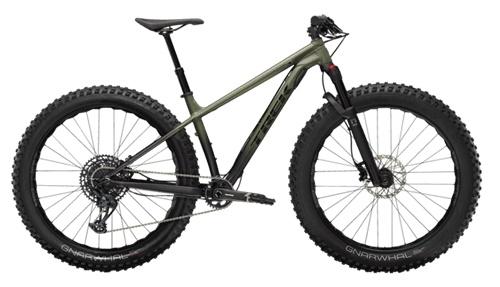
12. Trek Farley 7
- Frame: Aluminum
- Tires: 27.5 x 4.5
- Suspension: 130mm
- Weight: 35.10 lbs
- Pros: Fat Beefy Tires, Great for Sand and Snow, Tools to Fine Tune Geometry
- Cons: Is not ideal for all terrain and situations
The Farley 7 is a do-everything fat bike. Trek took their most successful mountain bike, the Fuel EX, and made it fat. The fat tires and wide rims create a stable platform that rolls smoothly over everything in sight. It’s also just as happy on singletrack as it is on sand and snow.
The Farley’s geometry is precisely that of the Fuel EX 29er – just with wider tires. The head angle, bottom bracket height, and chainstays are identical to its 29er sibling. The similarities make for a comfortable and efficient ride.
For anyone who knows that they want to ride a fat tire bike all year long, the Farley 7 is an excellent choice. You can invest your money in high-end components and not worry about having to replace them every season. And the geometry of the Farley 7 isn’t so wildly different from a traditional mountain bike that you’ll feel like you’re on some weird alien thing when you’re on the road or on non-snowy trails.
We found ourselves riding the Farley 7 hard on technical terrain at the Camping Feed and riding it easy on long cross-country rides. The suspension absorbs bumps well, even with a rigid fork.
This bike’s tires don’t have to be more expensive than some other fat bikes’ tires; it’s essential that they’re more grippy, last longer, and save weight. The Farley 7 is an attractive package for someone who wants to ride a fat bike like a standard mountain bike.
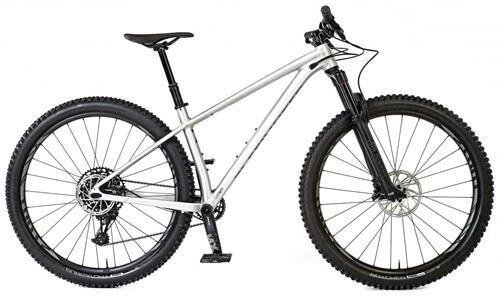
13. Specialized Fuse Expert 29
- Frame: Aluminum
- Tires: 29 x 2.6 or 27.5 x 2.8
- Suspension: 130mm
- Weight: 29.14 lbs
- Pros: Great bike for the money, Fun and Versatile, Great Geometry, Unisex, Various sizes
- Cons: Poor Fork Sizing, Less compliant frame compared to other mountain bikes
The Fuse Expert 29 is a modern take on the hardtail mountain bike. No matter how rough it is, it will eat up singletrack and spit it out behind you. It will climb like a billy goat on steroids. It will even handle drop-offs that make you hold your breath. The fun begins with an aluminum frame with snappy, responsive ride quality and a host of Specialized’s thoughtful touches that make for happy days in the saddle.
This 29er is incredibly light for a full-suspension bike, tipping the scales at an impressive 29+ pounds. Its snappy and speedy handling will leave you wondering why you’ve wasted so much time on heavy bikes that don’t deliver. At the Camping Feed, we were impressed by the way this bike handled technical climbs. Its well-designed suspension allowed us to pedal with ease through rough sections we would typically have been walking. The plush front fork and rear shock absorb rocks and roots without knocking you around or slowing you down.
As soon as we got the bike out on some downhill stretches, we were able to test out its capacity to soak up rough terrain without being bounced around too much.
At the Camping Feed, we found the bike’s geometry makes it quick and easy to maneuver–a desirable trait for those who want to be able to handle tight turns as well.
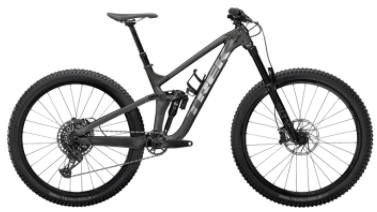
14. Trek Slash 8
- Frame: Aluminum
- Tires: 29 x 2.6 in. (front), 29 x 2.4 in. (rear)
- Suspension: 160mm
- Weight: 33.62 lbs
- Pros: Easy to use, Natural Geometry, Affordable, Impressive Suspension
- Cons: Not ideal for damp mud or rain
The Slash 8 from Trek is a winner. It’s a great all-around trail bike, a ton of fun to ride, and it’s easy on the eye. What more could you want? The Slash 8 is the perfect bike for riders looking for a high-performance enduro machine without spending top dollar.
The Trek Slash 8 optimizes its enduro race performance with a light, stiff frame that lets it charge hard through rugged terrain while maintaining the reactive, lively feel that enduro riders demand. The Slash 8 is also one of the best bikes for aggressive riders who want to go downhill fast but want to climb just as quickly.
It’s light and efficient, and the geometry lends itself well to pedaling uphill. The Slash’s handling is very agile and reactive. The bike responds quickly to steering inputs both on the climbs and on the descents. The cycle follows the line you point it in and isn’t overly affected by crosswinds or bumps in the trail. The Trek Slash 8 never feels sluggish or unresponsive.
At the Camping Feed, we appreciate the efficiency of the suspension platform. It doesn’t hold back your speed when you’re going downhill; yet, it doesn’t bounce wildly over bumps on the way up. The bike pedals efficiently thanks to a low bottom bracket, short chainstays, and a steep seat tube angle.
After testing, we maintained a high cadence without feeling like we had to muscle through our pedal strokes. The frame has a slight flex, especially in the rear triangle, but overall it’s very stiff for an enduro rig.
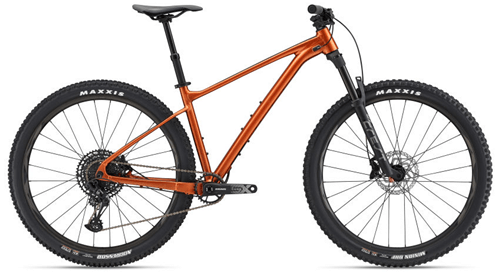
15. Giant Fathom 29 1
- Frame: Aluminum
- Tires: 29 x 2.5 in. (front), 29 x 2.5 in.
- Suspension: 130mm
- Weight: 29 lbs
- Pros: Great price, well designed, sturdy frame, reliable brand
- Cons: The gears can be confusing
Giant’s Fathom 29 1 is the first 29er XC hardtail to feature an aluminum frame, giving it stunning speed and control on the trail.
The Fathom 29 1 has a nimble-yet-responsive feel, making it perfect for singletrack, road riding, and trail riding. The Giant Fathom 29 1 is built to climb with ease.
The responsive suspension effortlessly moves through trail debris, while the lightweight aluminum hardtail frame delivers a solid feel that puts you in control without losing any speed or momentum. With a snappy trail tune and trail-tuned geometry, the Fathom 29 1 excels at tackling climbs.
The Giant Fathom 29 1 can be used as an all-day backcountry shredder, thanks to its trail design. The full carbon fork features 130mm of travel to soak up a rock garden and rooty sections of trail.
The stem increases rider control by allowing you to naturally position your hands higher up the handlebar for greater control when cornering through rocks and roots.
The Giant Fathom 29 1 is an efficient climber thanks to its Minimal-Slope Geometry (MSG). This allows you to maintain momentum while climbing, giving you more confidence on steeper slopes.
At the Camping Feed, we think Giant’s Fathom 29 1 is an excellent price for the design and sturdy frame.
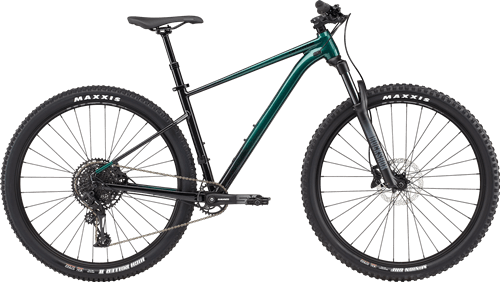
16. Cannondale Trail SE 2
- Frame: Aluminum
- Tires: 29 x 2.5 in. (front), 29 x 2.3 in. (rear)
- Suspension: 120mm
- Weight: 31.14 lbs
- Pros: High-tech, Wide Range Gearing, Great Price, Trail-tailored geometry
- Cons: Heavy Wheels, Not alot of options for color
What makes the most incredible mountain bike of 2025? The best mountain bike will offer a smooth and comfortable ride. It should also have a sturdy frame and be built of reliable components. A great mountain bike will be solid and durable while remaining lightweight for the rider.
This Cannondale Trail SE 2 is an excellent choice for a great price. It has a lightweight aluminum frame that weighs 29 pounds. Its fork is made of aluminum, too!
This bike features Shimano derailleurs and shifters, which ensure easy gear shifting. This bike offers 24 speeds, so you can easily adjust to your riding conditions. It has a very comfortable seat and grips so that you won’t get tired out on your rides.
This mountain bike is available in 4 sizes so that you can find the perfect size for you! The Cannondale Trail SE 2 has disc brakes, stopping on command every time! This bike has quality tires that grip well, even when it’s wet outside.
This Cannondale bike comes in 4 sizes (S, M, L, and XL), so you can find your perfect fit! And this bike comes with an affordable price tag, making it an ideal buy for beginners and experts alike! For outstanding performance on all trails at the Camping Feed, we recommend the Cannondale Trail SE 2.
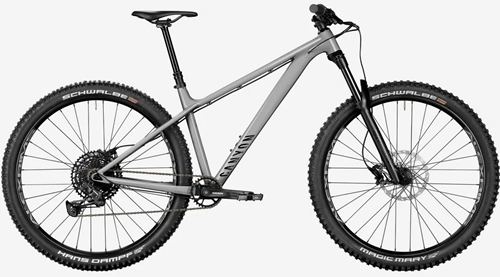
17. Canyon Stoic 3
- Frame: Aluminum
- Tires: Multiple options, both 27.5 x 2.8 in and 29 x 2.6 in
- Suspension: 140mm
- Weight: 32.41 lbs
- Pros: Great balanced handling, Lots of size options, Unisex,
- Cons: The bottom Bracket could be higher
The Stoic 3 is a balanced trail bike, which makes it suitable for riding on various terrain.
The frame is constructed from aluminum and features Canyon’s proven carbon fiber triangle. The aluminum frame makes the bike sturdy enough to handle the demands of aggressive riding while remaining light at just over 30 pounds.
Canyon’s Stoic 3 is available in both 27.5in and 29in wheel sizes, with the smaller front wheel offering a lower bottom bracket height. Available in XXS through XL, this bike is an excellent option for most riders.
No matter which size you end up with, all Canyon Stoic 3 models utilize a mix of Shimano and SRAM components for reliable shifting and braking performance. These components mean it’s well suited to adventures and trails where you’ll likely encounter long climbs and steep descents.
The bike also comes fitted with a dropper seat post that helps you get your weight over the front end while descending or climbing technical trails that require precision line choice.
Expect this bike to be at home on singletrack trails anywhere from XC to all-mountain terrain. The short chainstays help get the power down when you’re accelerating out of corners or off drops, while the slack head angle makes sure you still have good handling at speed. The frame is designed around 27.5in wheels but can accept 29er wheels if you leave the beaten path and take off-road routes.
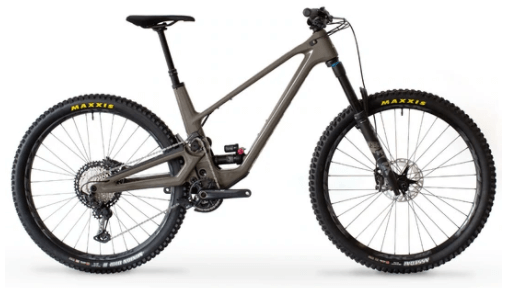
18. Forbidden Druid XT
- Frame: Carbon fiber
- Tires: 29 x 2.5 in. (front), 29 x 2.4 in. (rear)
- Suspension: 150mm (front), 130mm (rear)
- Weight: 30 lbs
- Pros: Comfortable, Great for Complex Rides.
- Cons: Need better shocking tuning options.
The Druid’s geometry is as dialed as its appearance, with an aggressive stance that begs to be pointed downhill at the next available opportunity. The head angle measures out at a steep 67 degrees, with a 74.5-degree seat angle. Add in a short stem and wide bars, and you’ve got yourself a bike that’s ready to attack the trailhead on — the only components missing are a set of knobbly tires and a rider with skills to match the bike’s capabilities.
The Druid’s suspension design is also worth noting, as it’s one of the most complex found on an off-the-shelf mountain bike today. Druid employs a single pivot design, but unlike most bikes of this type, it uses an idler instead of an upper shock mount to connect the swingarm to the rear triangle.
Along with various forged links, it results in more room for suspension movement inside the front triangle. In addition, a high pivot point pushes the rear triangle upwards into active ride height changes, which is aided by small bump compliance delivered by Druid’s system that includes four seals on each shock mount to reduce stiction during compression.
The design goal of the Druid was to create a frame that was as efficient as a hardtail but with the ability to run high-volume plus-sized tires. The high pivot point and single pivot achieve this by keeping the suspension active under power, particularly in the sag position. This means that the Druid has an exact feeling rear end that drives forward with each pedal stroke.
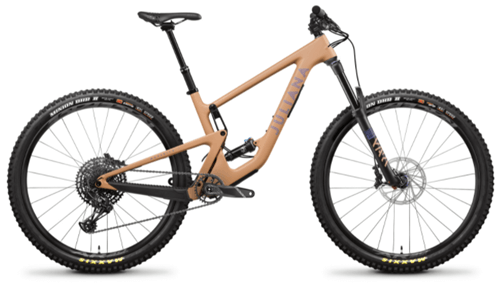
19. Juliana Maverick CC X01 29 RSV
- Frame: Carbon fiber
- Tires: 29 x 2.4 in. (front), 29 x 2.4 in. (rear)
- Suspension: 150mm (front), 140mm (rear)
- Weight: 32.03 lbs
- Pros: Long reach with seat angle, Suspension ideal for big hits, Seatpost is smooth
- Cons: Expensive pricetag for a high-quality mountain bike
The Juliana MacEachern’s CC X01 29 RSV is a great bike to ride, with its 29″ wheels being the perfect balance between speed and agility. Its lightweight carbon fiber frame is stiff and smooth, with all the typically weak corners reinforced with carbon for extra durability.
The suspension on this bike is also incredible, with the central pivot located on the swingarm, which gives you excellent control of your bike on any terrain.
The extra traction means you can go faster up the climbs, and the stability makes descending more fun. In addition, the fork’s lockout switch is easy to reach and allows you to lock out the fork on climbs or when you’re out of the saddle going downhill. Some other suspension bikes don’t have this feature which means you’re always riding in fully active mode, adding extra weight to your pedal strokes.
Juliana Macerick’s CC X01 29 RSV has proved itself as an all-mountain weapon, but it’s also fantastic fun on the trails, especially if you like to go fast!
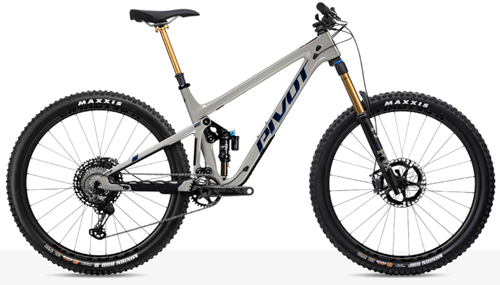
20. Pivot Switchblade Pro XT/XTR
- Frame: Carbon fiber
- Tires: 29×2.6 in (front), 29×2.6 in or 27.5×2.8 in (rear)
- Suspension: 142mm
- Weight: 5.7 lbs
- Pros: Lightweight, Great Suspension, Adjustable for all height riders, Versatile
- Cons: Short Chain limits uphill abilities, Loud brakes
Pivot’s Switchblade Pro XT/XTR is the most versatile trail bike on the market.
Some bikes are defined by the terrain they were born for; some by their handling; others, like the Switchblade, by their suspension. It is the first bike with a suspension that is optimized for climbing, descending, and pedaling. This suspension means it climbs like an XC bike, descends like a downhill rig, and pedals like an all-mountain bike. It does not excel at any one discipline, but it does everything well.
The Switchblade’s unique suspension lets you take advantage of every minute of traction on the trail, enabling you to carry speed and flow through corners that previously seemed impossible. It features a fully active suspension design and can be configured in three different settings: pedaling efficiency, climbing efficiency, and downhill performance.
The geometry is optimized to perform well in all three of these modes: you’ll find an abundance of stand-over clearance and room for large tires, and the slack head angle and low bottom bracket make it stable under power while remaining nimble in tight singletrack.
In a nutshell, the Switchblade is the bike you’d build if you could have anything. With this bike, you can instantly change settings on the fly so that they can tackle any trail, any time. In addition, the Switchblade’s DW-link® suspension is dialed for all-around riding – aggressive enough to send it in the air off big jumps and over technical sections, yet plush enough to float you through rough chunder without jarring your teeth out. It’s also tuned for climbing efficiency, so you can hang on every pedal stroke, even when things get steep.
Mountain Bike Buying Guide
- Bike Purpose
- Frame: Carbon vs. Aluminum
- The Weight Of the Bike
- Full-Suspension vs. Hardtail
- Wheel, Tire and Rim Size
- Gearing and other important parts
- Choosing a Complete Bike Build
- Women’s and Unisex Bikes
- Electric Mountain Bikes
- Consumer Direct vs. Local Bike Shop
- Price Advice
Bike Purpose
The first thing you need to do is determine what sort of riding you want to be doing. Mountain bikes are a little different from other bikes and essential for anyone who loves the outdoors. They’re more rugged and built to handle various conditions while providing a fun and adventurous ride. As mountain biking evolves, so does the technology behind them.
There are four main types of mountain bikes: cross-country, hardtail, suspension, and downhill/dirt jump. Do you want to stay closer to home, or are you planning regular trips to bike parks and trail centers? Each bike type has its inherent strengths and weaknesses, and it’s important to know what those are before you spend your hard-earned dough.
Frame: Carbon vs. Aluminum
For the most part, aluminum-framed bikes are still the most dominant material in the trail category, but carbon fiber is becoming more common. So what’s driving the popularity? The main advantage is a lot less weight and increased stiffness. Carbon fiber bikes weigh as much as one pound less than their aluminum counterparts. This can mean all the difference when you are on the side of a mountain. In addition, the rigidity of the material offers better strength to transfer weight with higher efficiency.
For committed cyclists, those are pretty clear performance advantages. But don’t lose sight of this: aluminum isn’t going anywhere soon. Industry giants such as Trek, Giant, and Specialized have been combining the benefits of alloys with carbon fiber for some time now—there is no doubt that they will refine their methods even more over the next few years.
The Weight of the Bike
One of the most important things to consider when purchasing a mountain bike is how much it will weigh. It is safe to assume that if the bike is heavier than the others in its category, it will be less responsive and more challenging to ride uphill. However, like many things in the cycling world, the weight of your mountain bike must be taken into context.
The weight of a mountain bike changes depending on the components and materials used, so the two most significant factors impacting your final number are price and material. Weight typically ranges from around 30 to 45 pounds, with carbon and aluminum bikes occupying the higher and lower ends of the spectrum, respectively. When we looked at the total weight of all 20 mountain bikes tested, we found only a difference of roughly 9 pounds between our two lightest models.
Full-Suspension vs. Hardtail
The debate between a hardtail and full suspension is as old as the best mountain bikes themselves. So we’ll make it easy for those who want to get right to the point: if you are experienced, you should buy a full-suspension bike. If you care about mountain biking, this decision should be a no-brainer. But how do we justify it?
A hardtail mountain bike only has a front suspension fork, meaning you don’t have a rear suspension. However, most mountain bikes today, even entry-level ones, have at least 120 mm of travel at the front, and this level of adjustment can usually be changed from inside the fork to suit your riding terrain. On the other hand, a full-suspension rig has a rear suspension that is typically adjustable as well, and it can be raised or lowered to match your ride requirements.
Wheel, Tire, and Rim Size
At one point, the only way to get a mountain bike was with 26 inches (in diameter) tires. As for width, the standard size used to be 2.35-inch tires, but now you can get up to 2.5 inches and even some wider rims up to 2.6 inches. Why? There’s no denying that big wheels roll over trail obstacles more quickly than smaller wheels, so if you want a bike that’ll help get over roots and rocks easier, then you will benefit from a more significant or 29er wheel.
It might be that you don’t believe bigger is better, and there are plenty of solid skeptics who still think 26-inch bikes are just as good as their bigger counterparts. The bigger wheels make the shock rate slower, especially in enduro races where courses are ridden faster and have more significant consequences.
Gearing and Other Important Parts
Mountain bikes are tricky to look at. An average mountain bike will have at least 15-20 moving parts, so it can be hard to decipher what kind of bike you are looking at. Components are just as important as the frame when it comes to choosing your dream mountain bike. For instance, cable disc brakes have been around for many years but have come into their own recently thanks to the industry moving toward hydraulic disc brakes.
Another example, it is essential to understand the intricacies of your drivetrain. For example, does it have one or two chainrings? This is particularly relevant because it is easier to shift on challenging courses with one chainring because of the hand tools. Lastly, you may consider the seat post and the ability to adjust your seat to your height and preferred position.
Choosing a Complete Bike Build
Even with the seemingly endless selection of trail mountain bikes available these days, finding the perfect ride for you can still seem like a daunting task. The rise in popularity of this category has ushered in a wide assortment of technologies that promise to make your rides faster, smoother, more precise, or all three. The number of options can be downright overwhelming, even for seasoned riders. You’ll need to consider how long you’ll ride, the terrain you cover, your skill level, your style of riding, and of course, your budget.
Remember, choosing the right bike is similar to finding the right fit for shoes or jeans. It isn’t one-size-fits-all. Each person’s needs are different, but some standard ground rules can help you determine which bike best suits your needs.
Women’s and Unisex Bikes
There is plenty of mountain bike options made to cater to women, whether it be a women’s specific size or a unisex style that comes in a wide range of styles. Women have just as much desire to shred the gnarly backcountry trails as men, and these bikes are made to take your way out there. The main difference is size and weight. Offering these slightly more lightweight and smaller mountain bikes help encourage everyone to mountain bike.
When shopping for a bike, don’t pass up the opportunity to handle a few different sizes and styles. You may be surprised to discover that the size you thought was perfect in your mind feels wrong in person. Instead, try standing over various bikes and checking out how they feel in your hands when you pick them up. And if you find yourself in between sizes, ask to take a test ride on a similar model with a more oversized or more petite frame.
Electric Mountain Bikes
The popularity of electric mountain bikes has seen an explosion in recent years. If you are in the market for a new e-bike, then you might be wondering how they are different. The most obvious difference is the motor. As more and more people are hurling themselves up hills, they’re looking for ways to make this process easier.
The e-bike or electric mountain bike has become more and more popular. Electric bikes were first used in the 1980s and were designed for recreational and fitness use. The electric motorcycle could reach speeds of up to 20 mph and come with a rechargeable battery that could last roughly 100 miles, depending on the terrain and your weight. Today, two additional classes of electric mountain bikes require and don’t require rider actions to move and reach speeds up to 28 mph.
Consumer Direct vs. Local Bike Shop
Local bike shops have been around since the invention of bikes. For decades, they have been the place to get a fine-crafted custom bike, get advice from professionals and enjoy the experience of an expertly assembled ride.
Today, you can go online. Buying a bike online direct to the consumer can be fantastic because you get to have access to an unlimited amount of options priced at affordable prices. This means a wider variety to choose from, at potentially lower costs. So, depending on your target, hunting for that deal might be worth it even though there are potential risks involved by not testing them in person.
If you are new to mountain biking, you should consider going to a local bike shop to try the mountain bike and get fit for the ideal bike. If you don’t like the price, go online to buy the bike, and you can always take it into the bike shop to be adjusted when it arrives.
Price Advice
There are three main price categories for mountain bikes. The amount of money you plan to spend on a new trail bike will dictate which type you ride in.
The first segment of the market consists of the most affordable models with prices from $400 to $1000. However, the bicycles in this category are generally made of heavier materials, making them difficult to use for off-road riding. The second group includes the newly developed hardtail mountain bikes, which still have a slightly higher price than hardtail road bikes ranging from $1000 to $3000. In this category, you’ll find both aluminum and carbon fiber frames with parts from reputable manufacturers such as Shimano, SRAM, and RockShox. The third segment is the mid-range, consisting of full-suspension bikes with quality parts from groups such as Fox or RockShox and ranging in price from $3000 to $5000. Finally, an upper range consists of the best mountain bikes with high-quality carbon fiber frames and forks and is priced at $5000+.


